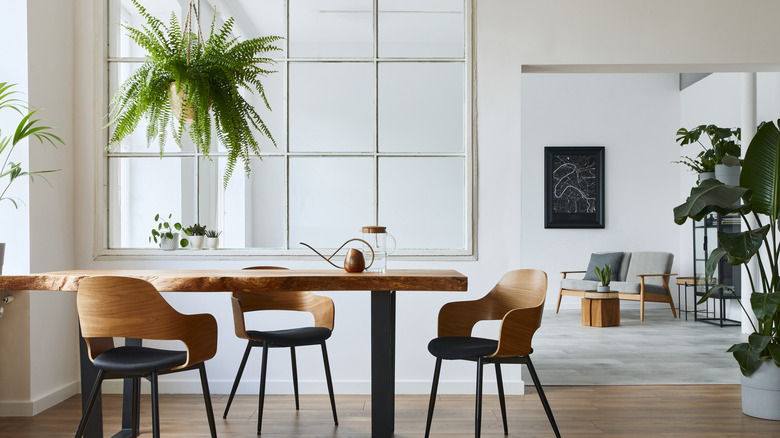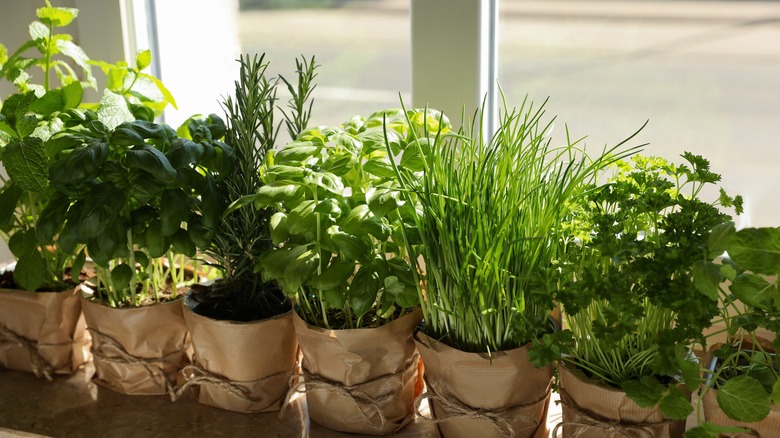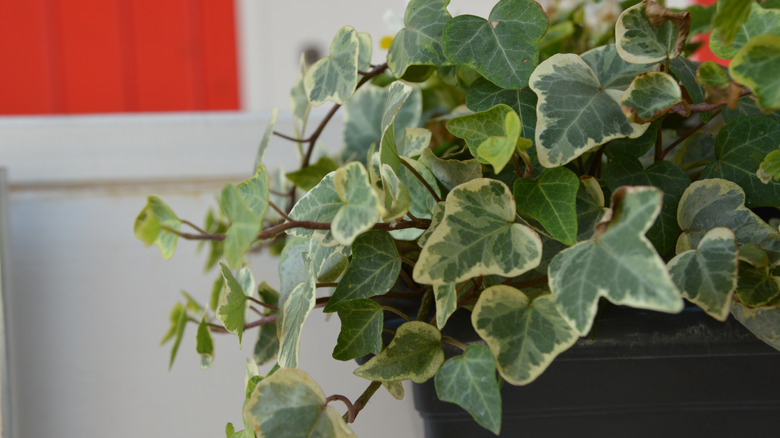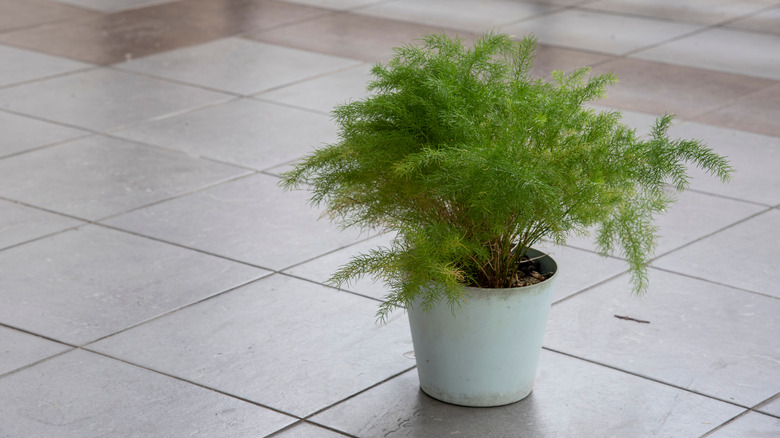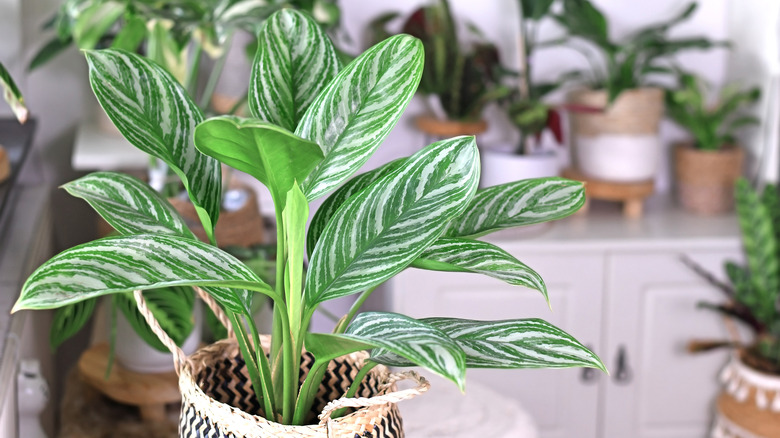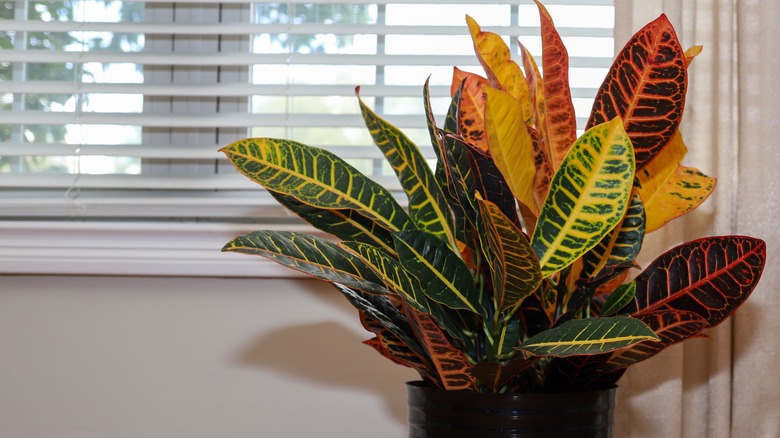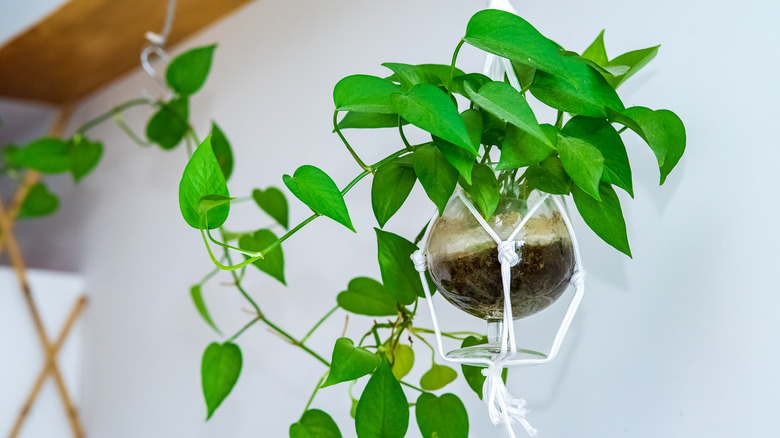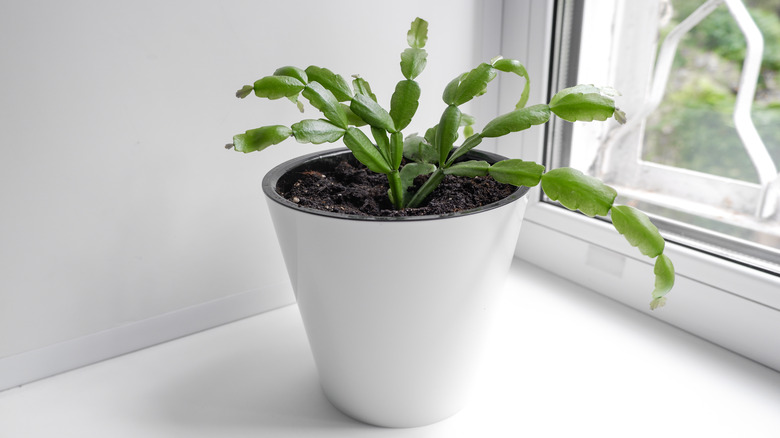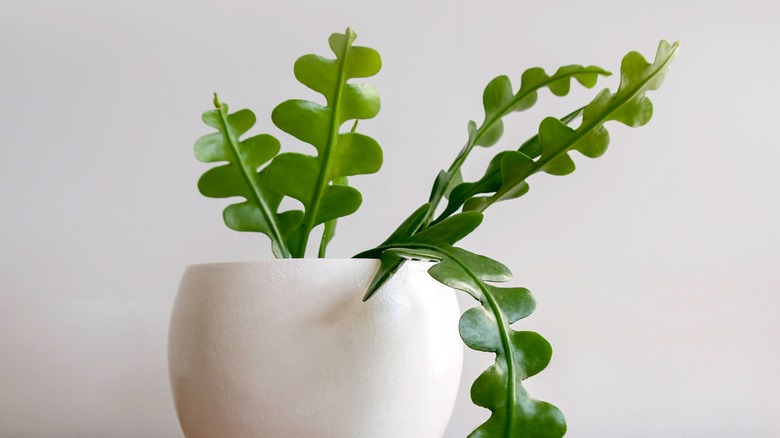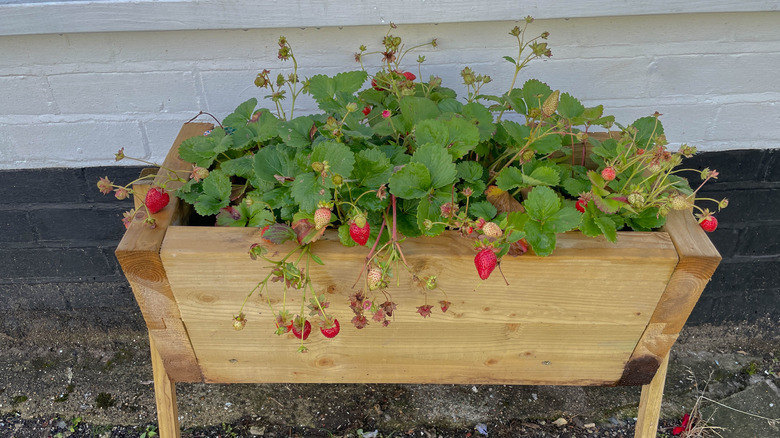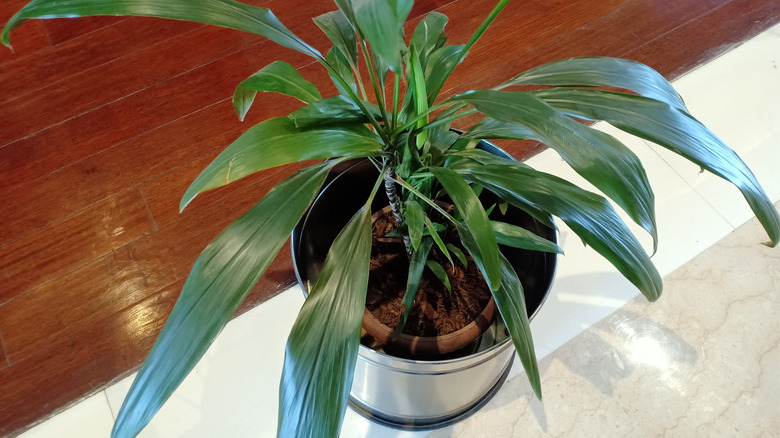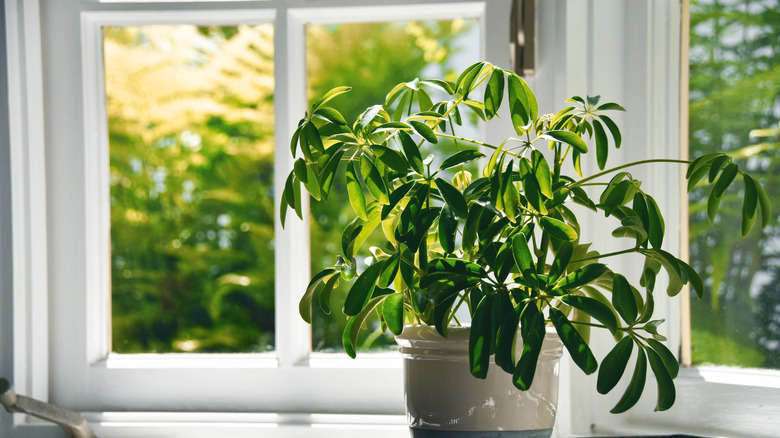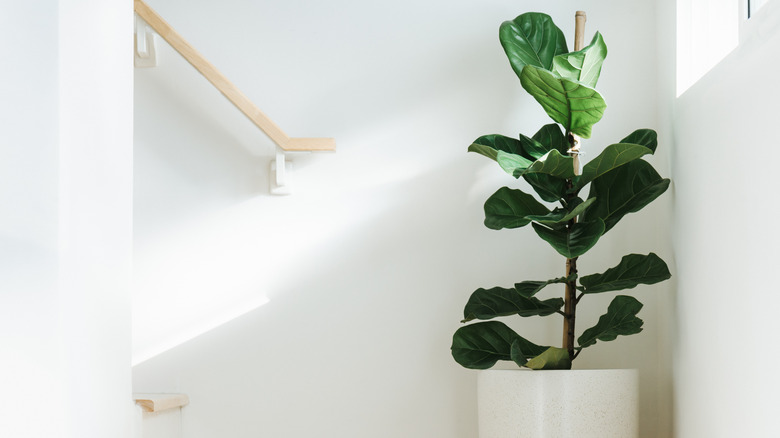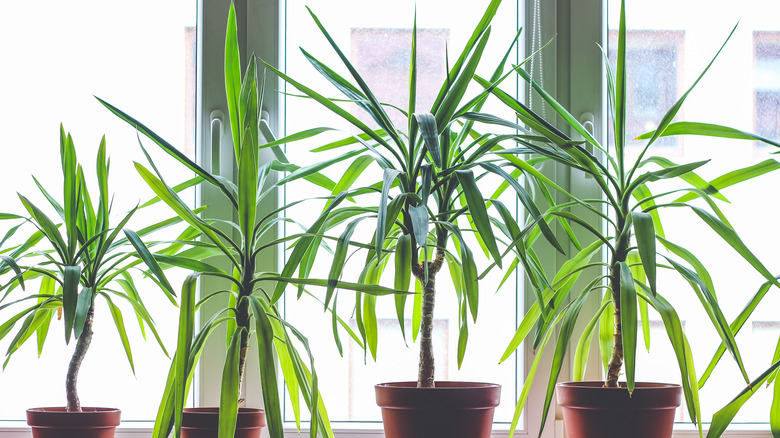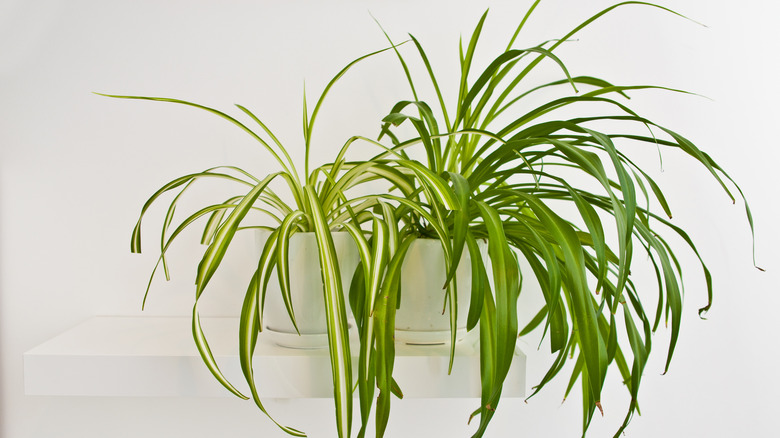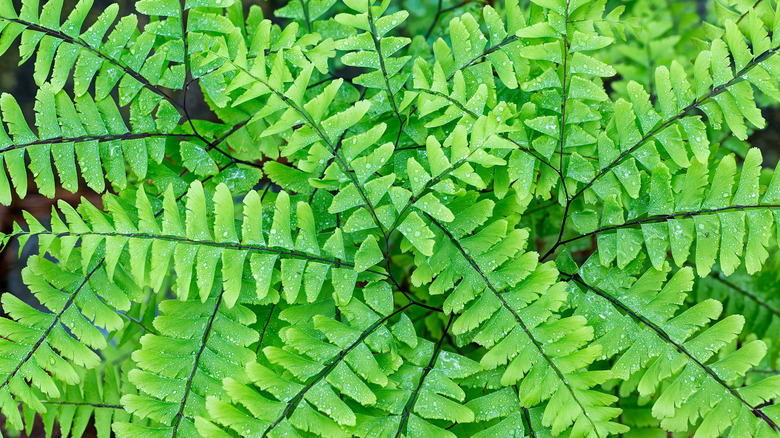The Best Indoor Plants For Every Room In Your House
Long-time houseplant owners know that not all plants can thrive in the same environment. There are five factors you must consider when choosing where to grow your latest plant purchase, as told by the University of Georgia Extension. They are light, soil, water, temperature, and humidity. One more consideration to make once you've learned each of these things is the overall maintenance level the species needs. All of this will help you decide which room to keep your plants in.
Take note of which rooms you would like to grow your newest plants in. Then, measure the amount of light and foot traffic, and the average temperature and humidity the rooms receive. This will make it even easier to pick out plants that will succeed in your home. If you'd like to get a head start on your plant wishlist, our guide will help you know which rooms in your house can accommodate these 15 plants.
1. The kitchen is for herbs
The Lamiaceae family is filled with herbs that make a wide range of dishes more flavorful. The family includes herbs such as oregano (Origanum vulgare), thyme (Thymus vulgaris), basil (Ocimum basilicum), and mint (Mentha spp.), as per Wildflowers and Weeds. All of these herbs, which become delicious spices, have similar habits, and they are easily grown on your kitchen window sill.
Bloom Season: Late spring and summer to fall
USDA Growing Zone: 3 to 9
Growing Conditions: Bright indirect light
Soil Type: Well-drained potting mix
Size: 6 inches to 3 feet tall
2. English ivy looks best in the bedroom
English ivy (Hedera helix) is best grown indoors due to its weedy behavior. As a houseplant, this vine is low-maintenance. It grows quickly with little attention, even in shadier locations, as said by North Carolina State Extension. If you've followed the trend of hanging fake ivy in your bedroom, consider switching it out for the real thing.
Bloom Season: Fall and summer
USDA Growing Zone: 4 to 13
Growing Conditions: Low to bright light
Soil Type: Moist, well-draining potting mix
Size: Up to 80 feet long outdoors, much smaller grown inside
3. Bathrooms support asparagus ferns
The asparagus fern (Asparagus densiflorus) is a perennial plant that is well-known for its ability to grow in shady and moist locations, as per the University of Wisconsin-Madison. Many of our bathrooms experience low light and tons of moisture each day. You can hang your fern in a planter above your shower or set it on a shelf for a pop of bright green color.
Bloom Season: Spring to fall
USDA Growing Zone: 9 to 11
Growing Conditions: Bright indirect light
Soil Type: Well-drained potting mix
Size: Up to 10 feet tall and 3 feet wide
4. Philippine evergreen plant for the guest bedroom
The Philippine evergreen plant (Aglaonema commutatum), which is also called the Chinese evergreen and the poison dart plant, is an herbaceous perennial with large, patterned foliage that is highly decorative. North Carolina State Extension notes that this plant grows well in dim lighting as long as it is watered somewhat regularly. It is a great option for your guest bedroom because it needs limited attention.
Bloom Season: Spring
USDA Growing Zone: 10 to 12
Growing Conditions: Low or medium light
Soil Type: Well-draining potting mix
Size: 1 to 3 feet tall
5. Croton in the foyer
Potted indoor croton plants (Codiaeum variegatum) in your foyer are a great way to welcome guests with bright, yet understated colors. These plants are well-known for their foliage, which can be colored in shades of yellow, orange, red, purple, and green, as told by Missouri Botanical Garden. If your foyer receives quite a bit of sunlight, your plants will appear even more colorful.
Bloom Season: Year-round
USDA Growing Zone: 11 to 12
Growing Conditions: Bright indirect light
Soil Type: Well-draining potting mix
Size: 2 to 6 feet tall and wide
6. Children's bedrooms and pothos plants
Pothos plants (Epipremnum aureum) are known to be very difficult to kill. If you have children who are interested in growing plants, this one can be a wonderful indoor houseplant to introduce them to. The Sill explains that the plant can withstand neglect, drought, low light, and dry air. It is also non-toxic so you don't have to worry about any accidental poisonings.
Bloom Season: Does not flower
USDA Growing Zone: 10 to 12
Growing Conditions: Bright to low light
Soil Type: Well-drained potting mix
Size: 6 to 10 feet long when grown indoors
7. Sunrooms are good for Christmas cacti
The Christmas cactus (Schlumbergera russelliana) has a reputation for being a heat and humidity-loving cactus. Unlike most species in the Cactaceae family, this one needs moist soil and a humid room to survive. As described by North Carolina State Extension, the Christmas cactus typically grows in rainforests as an epiphyte, and it's best for the plant if you can try to mimic this environment in your sunroom.
Bloom Season: Fall and winter
USDA Growing Zone: 9 to 11
Growing Conditions: Bright light
Soil Type: Moist and well-draining
Size: 6 inches to 1 foot tall
8. Fishbone cacti for the nursery
Fishbone cacti (Disocactus anguliger) are a unique Cactaceae species known for their wavy stems. Like the Christmas cactus, this is an epiphytic plant that grows on trees. It is good to grow in a nursery room because all parts of the plant are non-toxic, including the fruit of the plant, which tastes similar to dragon fruit, as said by Petal Republic.
Bloom Season: Summer to fall
USDA Growing Zone: 10 to 11
Growing Conditions: Bright indirect light
Soil Type: Very well-draining potting mix
Size: Stems can reach 1 foot long
9. Grow strawberries on the patio
You have a wide range of options when choosing the best plant for your patio. However, strawberries (Fragaria × ananassa) can simultaneously become ornamental and functional when you grow them in a container near your front door. According to North Carolina State Extension, the 'Chandler' variety is one cultivar grown in the U.S. that bears a high yield of berries in June with a great flavor.
Bloom Season: Spring
USDA Growing Zone: 5 to 9
Growing Conditions: Bright indirect light
Soil Type: Moist and well-draining potting mix
Size: 6 inches to 1 foot tall
10. The cast iron plant belongs in the office
The cast iron plant (Aspidistra elatior) is named for its resilience to harsh conditions such as shade, dry air, and drought, as told by Missouri Botanical Garden. In your home office, this plant can be left alone for days or weeks as long as it isn't exposed to direct sunlight or temperatures below 50 degrees Fahrenheit.
Bloom Season: Spring, rarely flowers indoors
USDA Growing Zone: 8 to 10
Growing Conditions: Bright, medium, or low indirect light
Soil Type: Well-draining and peaty potting mix
Size: 3 feet tall and 2 feet wide
11. Umbrella plant for the dining room
The umbrella tree (Schefflera arboricola) is a well-known broadleaf evergreen in the Schefflera genus, which is also home to many other trees and shrubs that are frequently grown outdoors in humid and hot states such as Hawaii and Florida, as per North Carolina State Extension. It will grow happily in your dining room nearby an indirectly sunny window, though it will not bloom indoors.
Bloom Season: Summer
USDA Growing Zone: 10 to 12
Growing Conditions: Bright indirect light
Soil Type: Well-drained potting soil
Size: 6 feet tall and 3 feet wide
12. Fiddle leaf fig for the living room
Fiddle leaf figs (Ficus lyrata) are a bold addition to any room in the home. Typically, they are positioned in central rooms where the plant can be monitored and appreciated for its effortless beauty. Missouri Botanical Garden suggests keeping it out of direct sunlight and watering it regularly. The fig tree will reward you with large, fiddle-shaped leaves if it is cared for properly.
Bloom Season: Rarely flowers indoors
USDA Growing Zone: 10 to 12
Growing Conditions: Medium indirect light
Soil Type: Soil-based potting mix
Size: 2 to 10 feet indoors
13. The library needs a Dracaena
Dracaena species (Dracaena spp.), such as corn plants, dragon trees, and lucky bamboo, are easy-to-care-for, tropical, houseplants that prefer indirect light and slightly humid air. In your library, any popular dracaena plant will thrive and show off its glossy, sometimes variegated, foliage throughout the year, as described by Miracle-Gro.
Bloom Season: Some species produce insignificant blooms
USDA Growing Zone: 10 to 11
Growing Conditions: Bright indirect light
Soil Type: Well-draining potting mix
Size: 6 to 10 feet tall
14. The man cave should seek spider plants
If you're lucky enough to have a man cave in your home, spider plants (Chlorophytum comosum) are one of the best plants to decorate it with. These no-fuss, non-toxic plants require the occasional watering and some indirect sunlight. The University of Wisconsin-Madison recommends propagating new spider plants from your old ones by simply placing offshoots on top of a container filled with potting mix.
Bloom Season: Spring
USDA Growing Zone: 9 to 11
Growing Conditions: Bright to medium indirect light
Soil Type: Well-drained potting mix
Size: 12 to 15 inches tall
15. Maidenhair fern in the basement family room
The maidenhair fern (Adiantum pedatum) is a shade-loving houseplant that can be grown in rooms without windows. It will survive in low light as long as its soil is plenty moist, as explained by Prairie Nursery. You can recognize the plant by its finely textured, bright green foliage and its arching branches.
Bloom Season: Summer
USDA Growing Zone: 3 to 8
Growing Conditions: Medium to low indirect light
Soil Type: Well-drained potting mix
Size: 1 to 2 feet tall
